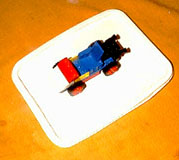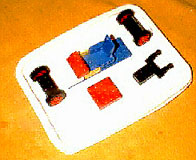




Making Life?
|
In the 1920's scientists Oparin and Haldane theorized that given a planet like the early Earth, with a reducing atmosphere (ie one with no oxygen), high UV radiation, and the basic chemical elements, then it might be possible to create organic molecules from inorganic precursors. In 1953 Miller and Urey tested their predecessors' ideas with a famous experiment that they said simulated those conditions. Sure enough it worked. They mixed water vapor, hydrogen, methane and ammonia and passed high-energy electrical discharges through the "soup". Within a few days they had made several organic compounds and amino acids - the building blocks of life. The experiments were modified and repeated and many chemicals, including all the twenty amino acids, lipids, sugars and the purine and pyramid-like bases of nucleic acids. If oxygen gas was added, however, the processes failed. However the experiment, which is now sometimes repeated in school laboratories, did show that the basic organic compounds that are necessary building blocks for life could be easily synthesized from elementary materials and "natural" conditions. Having the building blocks, though, is a long way from having the building! Imagine the building blocks of life as a tub of Lego parts, with life itself represented by a model that you may be able to build from the parts - a dune-buggy, perhaps. |
|
 
|
|
|
In nature, there is a solution to the dune-buggy problem. It is DNA. The DNA is both the plan and the means of issuing orders to make the "dune-buggy" of life. But take away the instructions and nature is back to "tipping the tub", just as it was before the first life appeared. The big mystery of life is not how it is assembled, but how did the first set of assembly instructions come into being, apparently in a dumb Universe without intelligent intervention? Despite the initial euphoria, the Miller-Urey experiment took us no further than repeating that very question in our quest to understand how life came about. It was, and remains, a long way from giving us the answer to the origin of life and the means to create it from first principles. By
the 1980's ideas about the early Earth had changed and the Miller-Urey
experiment was considered irrelevant. It no longer represented
the conditions of the early Earth, according to the new theories.
However now Miller and Urey's experiment is being revived, not
in its original form, but in a form that mimics conditions that
are thought to exist in deep space. |
|
|
Life from Deep Space (Right) Members of the Laboratory Astrophysics Group, at NASA Ames, are researching the origins of life in deep space: the team and some of their apparatus. © NASA, 1998 Recent
work by a team
of scientists led by Lou
Allamandola at NASA Ames Research Center at San Jose, has
shown how such compounds may form from basic elements and molecules
in interstellar space. He and his colleagues
created a vacuum chamber, cooled it to a very low temperature
of 10 K above absolute zero - typical of interstellar space -
and released into it some minute gaseous quantities of water,
hydrogen, nitrogen, oxygen, and carbon-monoxide, along with some
grains of sand - SiO2. |
|
PAH
coronene (C24H12) Molecule - One of the molecules
produced. © NASA, 1999
What was most surprising, though, was the fact that the chemical residues formed into vesicles similar to those found in the Murchison meteorite by David Deamer. The vesicles created in the vacuum chamber have some interesting and significant characteristics. One end is hydrophilic and the other end is hydrophobic - they both love and hate water! This enables molecules to be self-organizing in the presence of water and this ability, or characteristic, is a simple sorting process that may go some way towards understanding how life could self-organize, without some intelligent presence overseeing its assembly. In fact the vesicle behaves like a lipid, which is a fatty or oily bio- (rather than just an organic) molecule that is a major component in living cells and serves a variety of important functions. The most important of these functions is the creation of a boundary, enclosure or membrane, that isolates whatever is inside from the harsh and potentially destructive Universe outside. Surrounding and isolating a cocktail of potentially life-making chemicals in this way, where they can carry out their processes without external perturbations, must be vitally important if life is to "get started". If it is possible for lipids to form from "raw", inorganic chemicals, by simple processes that would be common in space, then a major factor in understanding the origins of life has been discovered.
It
is a step closer, towards self-assembling our "dune-buggy" of
life. We now tip the parts out on to a tray, they
now remain together, half of them no longer roll away across the
floor to get lost or trodden on! But it is still a
long way from a complete buggy. If we take a logical approach,
though, we might finally assemble the buggy by putting sub-assemblies
together - wheels, engines, chassis. The final buggy is
then made from a few sub-assemblies. Did life happen by
the same process? If so how did the subassemblies self-assemble?
Meanwhile back in the space simulation chamber, further development of the chemicals continued as the experiment progressed. Compounds known as quinones and alkaloids developed from the PAH's. Alkaloids are common in plants, where they play a crucial role in many aspects of a plant's life. Quinones assist in the electrons' mobility inside living cells. They are used in photosynthesis in plants and bacteria, and in animal cells where they become muscle and brain "food". It is becoming clear that life precursors could be created in space, from the simplest of chemicals and in the most unpromising of conditions. The question that now occurs is this: did life start in space, or was it that the chemical precursors of life could form in space and rain down on the planet as comets and other space debris? The second option is quite likely, but the true origin of the first living cell is still as elusive as ever. But major breakthroughs happened in the last decade of the last millennium and perhaps the answers to our fundamental questions about life will be answered soon. |
|

Dr
Allamandola © NASA, 1999
Meanwhile, in Calcutta, India, a team at the S N Bose National Centre for Basic Science has produced a mathematical model of how chemicals would evolve in a large cloud of interstellar dust and gas 7 light-years across which is collapsing under its own gravity. The cloud contained 12 elements, including Hydrogen, Carbon and Nitrogen. and it contracted for a million years. The simulation resulted in the production of Anadine, which is one of the bases for DNA. The full story is at Seeds of life. This is another step closer to building the buggy! |
![]()
Complex
organic molecules form quickly in old stars
Possible Astronomical
Implications for the Origin of Life-chemical synthesis in the circumstellar
environment,
NASA's
Thursday Classroom - Life on the Edge
David
Deamer - article
David
Deamer - personal
Create space!
- making vesicles
The process
- a vesicle
Exobiology
links
Jason Dworkin
Dr. Louis Allamandola
Welcome to the Astrochemistry
Lab - PAH Dust Ice
Teachers
Wormhole

Go
to
Home
| Space Station
| Mars | Rainforest
© 1999 Satellite Events Enterprises Inc.



